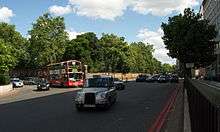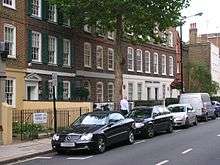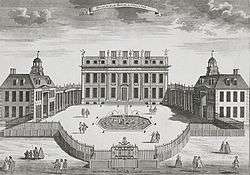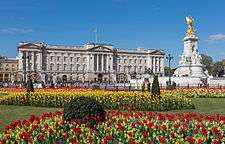Eia


Eia or Eye was a Medieval manor in Middlesex and now part of Central London.[1] A smaller manor called Ebury or Eybury, and the village of Eye Cross, were originally part of the manor of Eia – and derive their names from it. Both Ebury and a corruption of it, Avery,[2] can still be found in the names of local streets and other places.
The broader area covered by the original manor of Eia included much of the present SW1 postcode area, including: Hyde Park (which dates from 1536), the grounds of Buckingham Palace (1703) and Belgravia, a country road known later as Park Lane and most parts of Mayfair, Pimlico, and Knightsbridge.
The name Eia is believed to have originated as a latinisation of the Anglo-Saxon toponym eyai, which means "island",[3] in reference to a marsh that once dominated the area.
Middle Ages
Eia was a rural manor during the early medieval period, located on land around the underground River Tyburn (which still flows beneath the courtyard and south wing of Buckingham Palace), immediately west and north of Thorney Island, which became the site of Westminster Abbey.[4][5]
Ownership of the site changed hands many times in the Middle Ages. Its owners included Edward the Confessor and his queen consort Edith of Wessex in late Saxon times, and, after the Norman Conquest, William the Conqueror. William gave the site to Geoffrey de Mandeville, who bequeathed it to the monks of Westminster Abbey.
In the late 11th century, around the time of the Domesday Book, the manor of Eia was divided into three smaller manors: Hyde (the north-western part), Ebury or Eyebury/Eia (central area) and La Neyte or Neat (to the south-east). Neyte was a small island in the marsh (in what is now Pimlico), on which a house was built for the Abbot of Westminster Abbey.[6] (While Neyte may have been the origin of the name Knightsbridge, they were clearly distinct areas in the Middle Ages.)
By the 12th century a river crossing on the Tyburn, known as Cow Ford had become the site of a hamlet called Eye Cross. The exact location of the settlement is now uncertain (although it likely sat near, or in, the south-western corner of the present grounds of Buckingham Palace).[7]
Early modern era
In 1531, King Henry VIII acquired the Hospital of St James (later St. James's Palace)[8] from Eton College, and in 1536 he took ownership of the Manor of Ebury from Westminster Abbey.[9] These transfers brought the future site of Buckingham Palace back into royal hands for the first time since William the Conqueror had given it away almost 500 years earlier.[10]
By the early 17th century, the lease of the manor had passed through the hands of many different people. By then, Eye Cross had ceased to exist and the area of the former village was mostly wasteland.[11] During the reign of King James I, part of the freehold was sold (including the future site of Buckingham Palace), but the King retained part of the site, on which he established a 4-acre (16,000 m2) mulberry garden (near the north-west corner of the present day palace).[12] By 1649, however, Clement Walker, in his work Anarchia Anglicana, referred to "new-erected sodoms and spintries" – both terms referring to male prostitution – in "the Mulberry Garden at S. James's".
During the late 17th century, the freehold of Ebury passed from the property tycoon Sir Hugh Audley to his grandniece, Mary Davies. Both Audley and Davies were key figures in the redevelopment of Ebury Manor and the neighbouring Grosvenor Estate, into the modern suburbs of Mayfair, Belgravia and Park Lane. In Mayfair, North Audley Street, South Audley Street, and Davies Street were named after them.


Buckingham House, the mansion that would form the core of Buckingham Palace, was designed by William Winde for the first Duke of Buckingham & Normanby in 1703.[13] The property returned to ownership of the royal family (which had retained the adjoining site of the Mulberry Garden) in 1761, when the mansion was sold to King George III,[14] for £21,000;[15] some sources suggest £28,000.[16]
Ebury in modern place and other names
Ebury survives as a place name in: Ebury Street, Belgravia, Ebury Square, Ebury Wharf and Ebury Bridge, which crosses the former Ebury Canal. The name Avery, also found in many street names in SW1, is a corruption of Ebury.[17]
The modern hereditary title Baron Ebury, was created in 1857 for Robert Grosvenor. One of Grosvenor's enterprises was the Watford and Rickmansworth Railway, also known as the "Ebury Line", in Hertfordshire. The railway no longer exists and has been converted into the Ebury Way hiking trail.
Ebury Publishing is named after the location of its offices in the area, at Pimlico.
Footnotes
- ↑ F. H. W. Sheppard, "The Acquisition of the Estate", Survey of London 39: The Grosvenor Estate in Mayfair, Part 1 (General History) (1977), London, London County Council, pp. 1–5 (12 April 2015).
- ↑ Girling, Brian; 2013, Belgravia & Knightsbridge Through Time, Stroud, Glouc., Amberley Publishing Limited, p. 62.
- ↑ J. E. B. Gover, 1922, The Place Names of Middlesex, London, Longmans, p. 22.
- ↑ O. G. Goring, (1937). From Goring House to Buckingham Palace. London: Ivor Nicholson & Watson, p.15
- ↑ Patricia Wright, 2012, The Strange History of Buckingham Palace, Stroud, Gloucs., The History Press, p. 160.
- ↑ Wright, p. 160.
- ↑ Wright, 2012, p. 40.
- ↑ Goring, p. 28
- ↑ Goring, p. 18
- ↑ Shepherd, 1977
- ↑ Wright, pp. 76–8
- ↑ Goring, pp. 31–36
- ↑ Harris, p.22
- ↑ John Martin Robinson, 1999, Buckingham Palace, London , The Royal Collection, p. 14.
- ↑ Roy Nash, 1980, Buckingham Palace: The Place and the People, London, Macdonald Futura., p. 18
- ↑ Wright, p. 142.
- ↑ Girling, p. 62.
Bibliography
- Charles T. Gatty, 1921, Mary Davies and the Manor of Ebury, London/New York, Cassell.
- Brian Girling, 2013, Belgravia & Knightsbridge Through Time, Stroud, Glouc., Amberley Publishing Ltd.
- O. G. Goring, 1937, From Goring House to Buckingham Palace, London, Ivor Nicholson & Watson.
- J. E. B. Gover, 1922, The Place Names of Middlesex, London, Longmans
- Roy Nash, 1980, Buckingham Palace: The Place and the People, London, Macdonald Futura.
- F. H. W. Sheppard (ed.) 1977, Survey of London 39: The Grosvenor Estate in Mayfair, Part 1 (General History), London, London County Council (12 April 2015).
- John Martin Robinson, 1999, Buckingham Palace, London, The Royal Collection.
- Patricia Wright, 2012, The Strange History of Buckingham Palace, Stroud, Gloucs., The History Press.